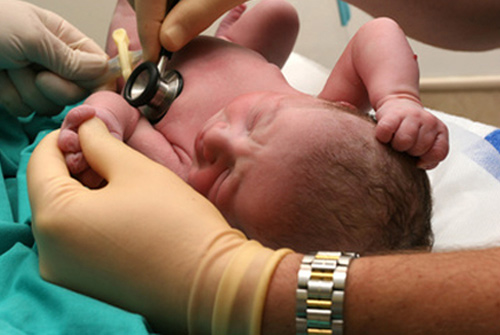HIV infections in newborns represent a huge health burden in developing countries with an estimated 300 to 500 infants infected every day in sub-Saharan Africa. HIV progresses faster in infants than in adults because of their weaker immune systems. The time of testing infants varies based on location with most programs testing children at 4–6 weeks of age. A new study shows there are benefits to treating children earlier, immediately after birth, and arresting the HIV in the first few weeks of life. But this opportunity may be missed by the current testing timeline.
The work was done by the Early Infant Treatment (EIT) Study, led by Roger Shapiro, MD, MPH, from the Harvard T.H. Chan School of Public Health and Mathias Lichterfeld, MD, PhD, and Daniel Kuritzkes, MD, both from Brigham and Women’s Hospital. The group sought to further investigate the possibility of arresting HIV infection in newborns from Botswana. As part of an international collaborative effort, the researchers conducted immunological and virological testing, finding that initiating ART immediately, rather than waiting a few weeks, provided measurable benefits for infants born with HIV. The work is published in a paper entitled, “Early antiretroviral therapy in neonates with HIV-1 infection restricts viral reservoir size and induces a distinct innate immune profile,” published in Science Translational Medicine.
“Our study suggests that strategies to test and treat infants immediately after birth may improve outcomes,” noted Lichterfeld. “We find,” he continued, “that ART initiation within hours after birth is doable and translates into multiple benefits for the infants—lower frequencies of reservoir cells and improved immune responses.” What excites him most about this work is that making a comparatively small change in the timing of treatment may have a large impact on long-term treatment outcomes.
The EIT study is a prospective clinical trial that enrolled infants from two major maternity hospitals in the Francistown and Gaborone regions of Botswana, a country with the third highest HIV-1 prevalence in the world. Infants enrolled in the study began ART in the first days (frequently, within hours) immediately following their births. The team compared their results to those of infants not in the study who received ART later (within a median of four months after birth). Infants were then followed for two years with blood sampling at regular intervals.
Investigators focused on 10 infants enrolled in the EIT study who were HIV positive at birth. The unique cohort of neonates with HIV-1 infection who started ART shortly after birth were followed longitudinally for about two years in comparison to control infants started on treatment during the first year after birth. The researchers measured the number of virally infected cells and innate and adaptive immune responses. The team observed that the number of reservoir cells was extremely small (significantly smaller than in adults who were on ART for a median of 16 years). The number of reservoir cells was also significantly smaller than in infected infants who started treatment later. The team also identified specific types of innate immune cells (NK cells and monocytes) that were on the rise while the viral reservoir size shrank, suggesting that these cells may influence or modulate viral reservoir cells.
Regarding HIV testing guidelines, the World Health Organization (WHO) suggests that a child should be diagnosed as early as possible and that earlier testing is an important way to move forward in advancing HIV treatment. But, there are logistical problems that prohibit some countries from moving to birth testing. Those countries continue to test at 4–6 weeks and do not offer birth testing. A question remains as to how best to support those countries to follow the WHO guidelines.
The authors noted that this study “demonstrates multiple benefits of rapid antiretroviral initiation, including an extremely small reservoir of intact proviral sequences, a reduction in abnormal T cell immune activation, a more polyfunctional HIV-1–specific T cell response, and an innate immune profile that displays distinct features of improved antiviral activity and is associated with intact proviral reservoir size.” Together, they noted, these data “provide strong empirical evidence supporting the immediate initiation of ART for neonates with HIV-1 infection.”
Further, Kuritskes said that studies such as this one show that “it is critically important to extend studies to infants and children and it demonstrates the feasibility and importance of doing this type of research in these types of settings.”







